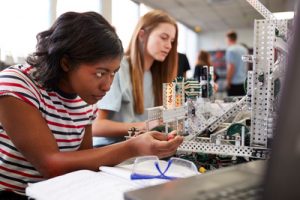Day 1 of “d.school comes to Tokyo Tech” workshop, a part of course; “Fundamental Group Work for Leadership【F】” and a ToTAL/OPEN Program,
has been reported by Dwinanri Egyna, 2019 ToTAL student. (*英語にて報告/reported in English)
“d.school comes to Tokyo Tech 2019” was my first design thinking activity. This workshop was facilitated by two instructors; Thomas Both and David Janka, from the Hasso Plattner Institute of Design at Stanford University (so called “d.school”) to give us a slice of design thinking education that is carried out there and provided us with tools to start our own design thinking activity. The workshop was held as the 6th 2-days workshop at Tokyo Institute of Technology commencing from 2014.
I. Ice-breaker
The workshop started at 9.30 am in the morning on Saturday (26/Oct). It seemed that since most of the students there did not know each other. In some groups, introductions were started, but for the shyer students, they were quiet. This was why the ice-breaker was very important to kickstart the workshop.
In the ice-breaking session, we were asked to make a business card with 2 sides. On the A-side was our “professional identity”, one that would likely be in our real business card like our name, major, occupation, etc. However, on our B-side was our more “unique identity”. Things that people will not immediately correlate with us. For example, on my A-side was about my current position and previous occupation as a graduate student and engineer. But on my B-side were things that could be called my hobby but a little bit more than that, like a history geek and procrastinating creative writer.
II. The Banana-ad
The next session was about fascinations. Fascinations are things that interest us and prompt us to notice more things about what was happening around us which would lead to a problem-solving design thinking.
In this session, we were asked to list about our fascination and share it with another person. Imagine how surprised I was when I found that the person I was sharing with had very similar fascination to me! I personally feel that one of the challenges to get my ideas out there was the lack of people with similar interest. The short few minutes showed me that if I take the time to talk to other people I would not only find range of different point of views but also people with similar interest to brainstorm with.
Following this was the surprising bit. We were given the assignment to make a very simple “print advertisement” to promote bananas, and use one’s fascination to inspire ideas. We were given 24 minutes to figure out a design using the banana as the centre piece of our ads, add a tagline to it that reflects our interest and correlate with our banana design, and submit it.
At first the idea seemed to be quite daunting. However, I found it very easy to talk with my previous partner with similar interest about our ideas and built it up from that. The 24 minutes which sound very short of a time to make ads was actually the perfect pressure needed to trigger an efficient creative design.
III. Design Behaviour Activities
We were given prompts which started very substantial like an object name, and then, represent it within a group with our bodies.There was a lot of laugh which makes the activity very fun. However, the most interesting thing was to see how other groups would interpret the same prompts in different designs.
IV. Prototyping
Following the Design Behaviour Activities session, we moved on to something that is very important to design thinking process: prototyping. After lunch break, we moved on to the more traditional sense of prototyping where we were given prompts of certain problems and were asked to design a solution to that using very simple crafts material like ice stick and tapes. After we finished our design, we were given time to get feedback from the group that worked on a different topic and give us new perspective to improve our design. Following that, we were given the chance to get feedback from group working on the same topic which gave us different perspective and approach to our way of thinking and open more ideas to either collaborate or improve our design.
Finally, the big task was to design a blender to be used by a six-year old. In our group, we spent a little more time discussing about our design compared to other groups. In the end, I think we reached quite a solid idea that would ensure ease of use and safety. However, I found the feedback to be still very fruitful because the other groups asked questions that prompted us to take the design further.
All in all, the main idea of this session was prototyping is not a one-time process but a series of design evolution that could start from something very simple like sticks and tapes to something that is more substantial like 3D model before getting to something that is even higher-resolution. One of the most important point was to get many feedbacks in the early part of the process when the cost of modification and improvement is not as high as later in the process.
I never considered myself as a creative person, so at the start I was quite apprehensive, wondering if I would enjoy the workshop. Much to my surprise, the workshop did not only show that I can do design thinking with my own approach, but also that I could find that bit of creativity in me and when I hit a wall to collaborate with other different ideas that comes from communication. The ice-breaking session was particularly interesting because often time we are trapped in our professional identity and forgot that it is not what us is all about. In fact, our B-side can be a very strong tool for us to create innovative designs.
Reported by; Dwinanri Egyna, Energy Science and Engineering, M2, 2019 ToTAL student














